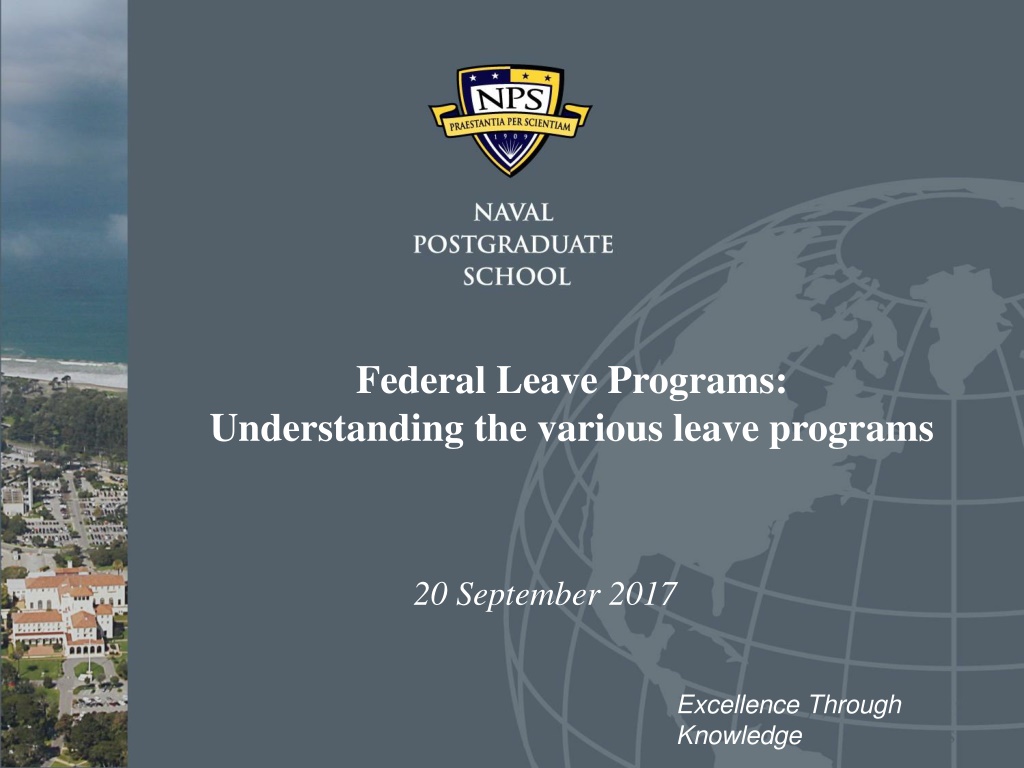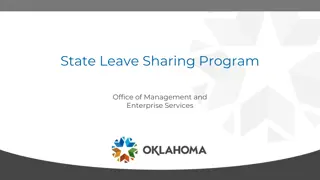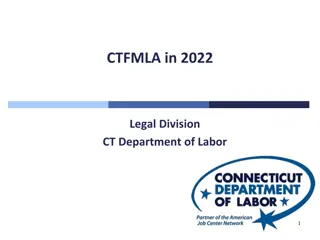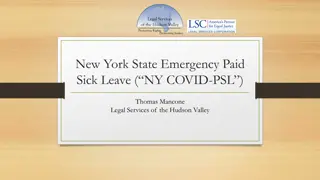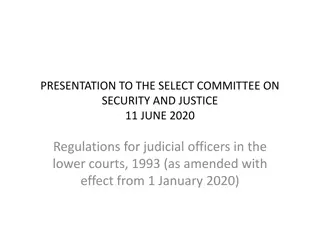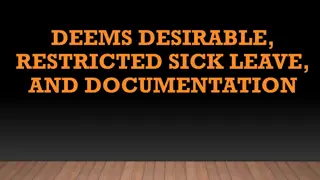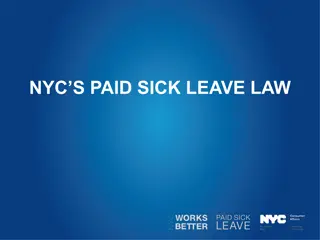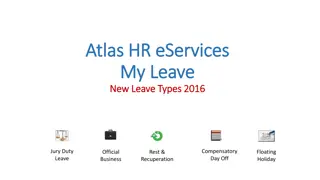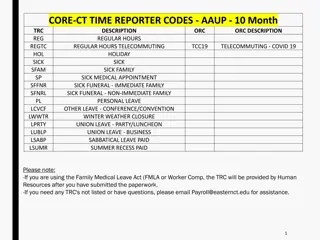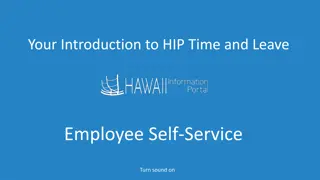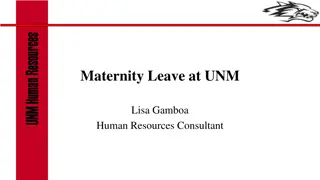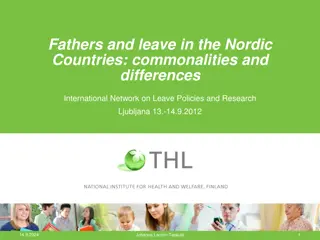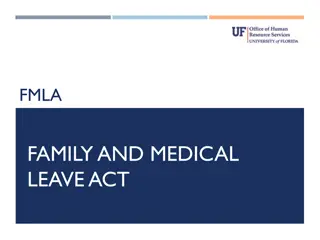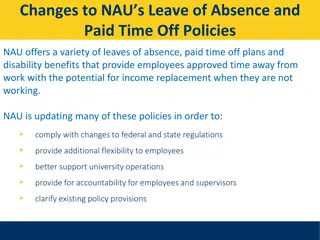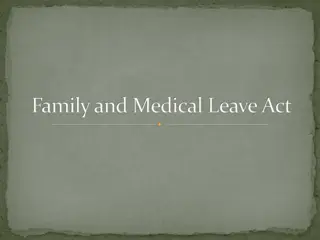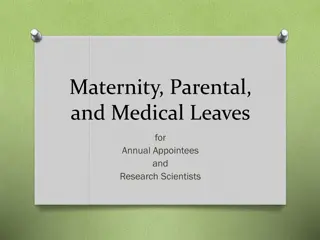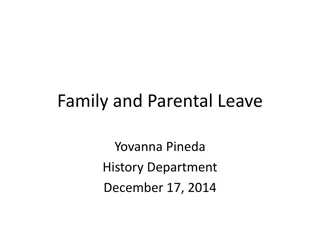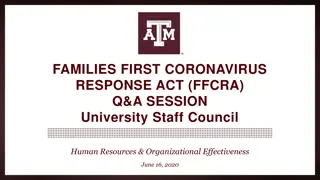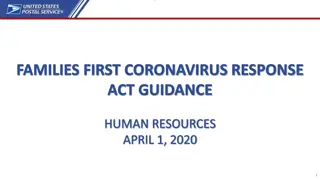Understanding Federal Leave Programs Overview
This overview provides insight into various federal leave programs, including annual, sick, and family leave, as well as programs like FMLA and LWOP. It discusses accrual rates, approval processes, usage limits, and requirements for sick leave. The overview aims to enhance understanding and compliance with federal leave policies.
Download Presentation

Please find below an Image/Link to download the presentation.
The content on the website is provided AS IS for your information and personal use only. It may not be sold, licensed, or shared on other websites without obtaining consent from the author. Download presentation by click this link. If you encounter any issues during the download, it is possible that the publisher has removed the file from their server.
E N D
Presentation Transcript
Federal Leave Programs: Understanding the various leave programs 20 September 2017 Excellence Through Knowledge
Purpose The purpose of this overview is to help ensure understanding of the various leave programs. This overview will include a discussion on the following types of leave: Annual Sick Family and Medical Leave (FMLA) Leave Without Pay (LWOP) Absence Without Official Leave (AWOL) Administrative Leave Disabled Veterans Military Court This overview will also include a discussion on the following programs: Voluntary Leave Transfer Program Advanced Leave Program This overview will also include a discussion on Adjustment of Work Schedules for Religious Observances.
Annual Leave Leave Accrual Rates (per pay period): Less than 3 yrs of service = 4 hours 3 15 yrs of service = 6 hours 15 yrs or more = 8 hours Annual leave is subject to prior approval. Must be requested and approved prior to being taken. Management can disapprove with justification. Properly requested annual leave can only be denied for mission-related reasons. Limitation on accrual: 240 carryover balance. Anything over 240 use or lose Use or lose : Restoration of annual leave in excess of the maximum ceiling limited to administrative error, exigency of the public business or sickness of the employee.
Sick Leave An employee is entitled to use sick leave when he/she: Receives medical, dental, or optical examination or treatment; Is incapacitated for the performance of duties by physical or mental illness, injury, pregnancy, or childbirth; Would jeopardize the health of others by his or her presence on the job because of exposure to communicable disease. Family care or bereavement Care of a family member with a serious health condition Adoption-related purposes There is no limitation on the amount of accrued sick leave that an employee can accrue. Must be requested and approved by the leave granting official. Requests should be made as soon as possible, but in any event no later than two (2) hours after the beginning of the employee s shift, circumstances permitting.
Sick Leave, continued Prearranged medical, dental, or optical appointments will be made at least 24 hours in advance, unless emergency arises. Unless other arrangements have been made, sick leave request must be made on each day of absence. Supporting Evidence for use of sick leave: If sick leave is less than three (3) days: Not required unless supervisor has reason to believe the employee is abusing sick leave privilege. If sick leave is in excess of three (3) days: Employee must provide administratively acceptable evidence or medical certification within 15 days of the Employer s request. Administratively acceptable evidence: Employee s prognosis, dates of incapacitation, restrictions on performance of duties and expected return to duty date. Sick Leave Usage Limits per Leave Year No limitation for an employee s own personal medical needs Up to 13 days (104 hours) for general family care and bereavement Up to 12 weeks (480 hours) of sick leave for serious health condition of self or to care for a family member with a serious health condition
Sick leave to care for a family member Up to 104 hours (13 days) of sick leave each leave year can be used for: Care of a family member (illness, injury, pregnancy, childbirth, and medical/dental/optical appointments); or Attend the funeral of a family member (bereavement) *Please note: If employee uses any portion of the 13 days for general family care or bereavement in a leave year, that amount must be subtracted from 12 week entitlement. Definition of family member: Spouse, and parents thereof; children, including adopted children and spouses thereof; parents; brothers and sisters and spouses thereof; domestic partner, committed relationships, or any individual related by blood or affinity whose close association with employee is equivalent of family relationship.
Sick leave for serious health condition Up to 12 administrative workweeks during any 12-month period for: The birth of a child of the employee and care of such child; The placement of a child with the employee for adoption or foster care; The care of spouse, child or parent of the employee who has a serious health condition; A serious health condition of the employee that makes employee unable to perform essential functions of his/her position. Under certain conditions, an employee may use the 12 weeks of leave intermittently. Employee may elect to substitute annual and/or sick leave for unpaid leave. Must provide notice of intent to take family and medical leave not less than 30 days before leave is to begin, or, in emergencies, as soon as practicable. Medical certification may be requested to support request to care for employee s spouse, child or parent with serious health condition or for serious health condition of employee. Serious health condition is an illness, injury, impairment, or physician or mental condition that involves inpatient care in a hospital, hospice, or residential medical care facility or continuing treatment by health care provider.
Leave Without Pay (LWOP) Although unpaid, LWOP is an approved leave status. Not an employee entitlement. Circumstances for granting LWOP include but are not limited to: Fulfill family responsibilities Increase job ability Protect/improve employee health. Employee s do not accrue bi-weekly annual/sick leave when accumulate increments of 80 hours of LWOP. Excessive LWOP can adversely impact service computation date towards retirement. Timekeeping Code: KA
Absence Without Official Leave (AWOL) Employee has not been authorized or approved leave Leave request was denied Charged in 15 minute increments May be basis for further disciplinary action Charged only during regular tour of duty Timekeeping Code: KC
Administrative Leave Also referred to as excused absence Administratively authorized absence from duty without loss of pay or charge to leave. Limited to those situations not specifically prohibited by law and satisfies one or more of the following: Absence is directly related to department or Agency mission; Absence is officially sponsored or sanctioned by the head of the department or Agency; Absence will clearly enhance the professional development or skills of the employee in his/her current position; or Absence is as brief as possible under the circumstances and determined to be in Agency s interest. Examples include 59 minute rule , blood donation, severe weather. Timekeeping Code: LN
Disabled Veteran Leave Wounded Warriors Federal Leave Act of 2015 Employee hired on or after November 5, 2016, who is a veteran with a service-connected disability rating of 30 percent or more from VA is entitled to up to 104 hours of disabled veteran leave for purposes of undergoing medical treatment for such disability. One-time benefit allowing a single, continuous 12-month period, beginning on the first day of employment is which to use the leave or it will be forfeited with no opportunity to carry over. Employee must: Be in the civil service Be covered by the disabled veteran leave statute Be a veteran as the term is defined in 38 USC 101(2) Have a service-connected disability rating of 30 percent or more Be hired on or after November 5, 2016; and Be subject to a leave system for which leave is charged. 12-month eligibility period: First day of employment is the later of: The date the employee is hired; or The effective date of the employee s qualifying service-connected disability rating. Specific timekeeping code PW in Ehz field
Military Leave Eligible: Any full-time federal civilian employee whose appointment is not limited to one (1) year. Part-time employees will have leave entitlement pro-rated. Provides 15 days per fiscal year for active duty, active duty training, and inactive duty training. An employee can carry over a maximum of 15 days into next fiscal year. Consists of regularly scheduled unit training periods, additional training periods, and equivalent training (DoDI 1215.6, March 14, 1997). Minimum charge to leave is one (1) hour. Employee may be charged military leave only for hours that he/she would otherwise have worked and received pay. Timekeeping code: LM
Court Leave Entitled to paid time off without charge to leave for service as a juror or witness. Employee responsible for informing his/her supervisor of summons for service for 1 day or more or for a substantial part of a day. Jury duty: An employee who is summoned to serve as a juror in a judicial proceeding. Witness: An employee who is summoned as a witness in a judicial proceeding in which the Federal, State, or local government is a party. Official Duty: An employee who is summoned as a witness in an official capacity on behalf of the Federal Government is on official duty, not court leave. Fees/Expenses: Employee must reimburse to their Agency, fees paid for service as a juror or witness. However, monies paid to jurors or witnesses which are in the nature of expenses (e.g., transportation) do not have to be reimbursed. Timekeeping Code: LC
Voluntary Leave Transfer Program (VLTP) Employees may donate annual leave directly to another employee who has a personal or family medical emergency and who has exhausted available paid leave. To be eligible for consideration for enrollment: Submit Application to Become a Leave Recipient which includes certification regarding the medical emergency from one or more physicians to HRO through supervisor. Medical emergency is a medical condition of employee or employee s family member that is likely to require the employee to be absent from duty for a prolonged period and will result in a substantial lose of income because of the lack of available paid leave. Absence from duty without available paid leave because of medical emergency is (or is expected to be) at least 24 work hours. Leave recipient may only use donated annual leave for purposes related to the medical emergency for which the leave recipient was approved. Annual leave transferred under VLTP may be substituted retroactively for any period of LWOP because of the medical emergency or used to liquidate indebtedness incurred for advanced annual or sick leave used because of medical emergency.
Advanced Leave Advanced Annual Leave: Annual leave may be advanced to an employee in the amount not to exceed the amount the employee would accrue within the leave year. Advanced annual leave is liquidated by subsequently earned annual leave or by payment upon separation from Federal service. Advanced Sick Leave: Sick leave may be advanced to an employee for the same reason it grants sick leave. 240 hours is the maximum amount of advanced sick leave a full-time employee may request. Request for advanced sick leave is essentially a request for sick leave, therefore, the medical documentation requirements for granting sick leave apply. Managers should NOT advance annual or sick leave to an employee when it is known (or reasonably expected) that the employee will not return to duty. All advanced leave requests must route through HRO for final approval prior to submission to timekeeping. Timekeeping Codes: LB (Advanced Annual Leave) LG (Advanced Sick Leave) * Visit http://my.nps.edu/web/hro/absence-leave for Request for Advance Leave form which outlines routing/approval process.
Adjustment of Work Schedules for Religious Observances Employees whose personal religious beliefs require that he/she abstain from work at certain time of the work day/week, must be permitted to work alternative work hours. Submit written request for adjusted work schedule (which must state for religious purposes) and articulate need to abstain from work. Supervisor and employee should determine whether hours will be scheduled before or after the religious observance. Approval should not be granted until a schedule is agreed upon as to when employee will work to make up the time. Employee should only be allowed to accumulate the number of hours of work needed to make up for absences from work for religious observances. Overtime pay provisions of Title 5 do not apply to employees who work different hours or days because of religious observances. Timekeeping Codes: CR: Religious Comp Time Earned CA: Religious Comp Time Taken
Resources/Points of Contact Human Resource Office Intranet Site: http://my.nps.edu/web/hro/ Office of Personnel Management: http://opm.gov/ For any questions regarding leave programs, please contact Kenneth Stewart Labor/Employee Relations Specialist kastewar@nps.edu Extension 2007 Cindy Dunn Labor/Employee Relations Specialist cdunn@nps.edu Extension 2244 or Jennifer Amorin Chief, Labor/Employee Relations jlamorin@nps.edu Extension 3308
